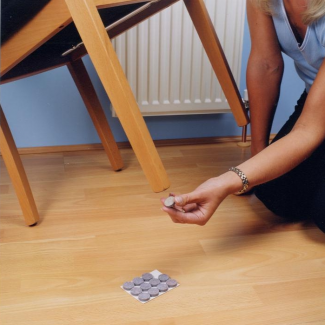Protecting Laminate Flooring from Wear and Tear
Laminate flooring is generally a hard-wearing, durable floor covering, but these simple tips can help reduce the risk of damage.
Laminate flooring today is generally high-quality and designed to withstand the wear and tear of daily life, even in busy family homes. Accidents do happen, however, and even the toughest floors will be at risk of damage over time, especially in busy areas of the home. These simple tips will help you protect your laminate flooring from scratches, stains and marks, keeping it looking as good as new for longer.

Attach Protector Pads to Furniture
Felt protector pads are a cheap and practical way to protect your laminate flooring from scratches or marks caused by heavy furniture. The pads simply stick to the bottom of chair legs, table legs or the feet of any other furniture and act as a buffer between the hard furniture and your flooring. They are inexpensive, can be applied in a matter of seconds and are very effective. They are particularly useful on items of furniture that tend to be moved around a lot, such as dining chairs.
Use Rugs or Runners in Hallways
If your entrance hall is fitted with laminate, consider adding a heavy-duty runner or rug. Not only will this protect your floor from scratches caused by debris and dirt trodden in from outside, but it will give your home’s entrance an instant makeover for very little expense.
Trim Your Pets’ Claws
If you have cats or dogs, you’ll know the sound their claws make as they trot across laminate flooring. While normal walking shouldn’t damage your floor, if your pets are particularly playful, have very sharp claws or are very heavy, the risk of damage is greater. Trimming your pets’ claws (or getting a vet or groomer to do it for you) reduces the chance of scratches occurring.
Keep an Eye on Humidity Levels
Ordinary laminate shouldn’t be installed in high-humidity rooms like bathrooms or kitchens unless it is specifically designed to withstand high levels of moisture. High levels of humidity can cause laminates to warp over time, and the only fix for this is to replace affected sections. Some homes are more humid than others, however, so if this applies to your home – it could be that you have a lot of indoor plants, or your home isn’t very well ventilated – consider investing in a dehumidifier.
Feel free to contact us for more information.
